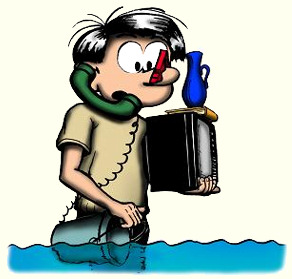|
Broken Valves And Flooded Basements
By my own personal calculations – in other words, I'm just guessing here – it takes a grand total of about 42 seconds to walk from my couch to where the valve is in our front yard, uncover it, turn it off, cover it up again and return to the couch. In fact, it probably took longer for me to type that last sentence about doing it than it would take to actually do it. And yet I didn't. Not that I wasn't reminded to do so. The city sent out a notice, reminding us that plagues, pestilence and all manner of apocalyptic trauma could follow our failure to turn off that valve. Well, OK – their warnings actually had more to do with the possibility of creeks flowing through our yards and geysers erupting through holes in broken water pipes. But I don't know – having Old Faithful explode in my front yard sounds pretty apocalyptic to me. My wife, Anita, also reminded me – several times, as I recall. Each of those conversations went something like this: "Joe, have you turned off the valve to the sprinkler system?" she would ask sweetly even though I'm confident she already knew the answer to the question. "Oh, that's right," I would say in between handfuls of popcorn. "I need to do that." "It would be great if you could do it before the ground freezes," she would add, hopefully. "I know," I would say, only with my mouth full of popcorn it sounded more like, "Ah mkpfh." Then I would swallow and add sincerely: "I'll do it tomorrow – I promise." Only I didn't. In my mind, there was no great rush because we were having such a mild fall, followed by an even more mild winter. And on those rare occasions when I actually thought about doing it, I felt no great rush to complete the project because there seemed to be no really compelling need. I kept telling myself that if it got really cold, or if a heavy snow started to fall I would rush out and turn that valve off. After all, it would only take about 42 seconds to do it. And it was such a simple thing; even I couldn't screw it up. Only I did – by not doing it. And now we're paying for it, with a couple of cracked sprinkler valves, a flooded basement floor and probably some damage to the wall through which the water traveled on its way from our broken valves to the basement floor. By the time we're finished with the repairs to our sprinkling system and to the flood-damaged room in our basement, my inaction will have cost us several hundred dollars, not to mention significant inconvenience to the family and the wear and tear on Anita's tongue, upon which she has to keep biting down to keep herself from saying a much-deserved "I told you so." One of the great lessons life teaches us all eventually is that procrastination is not simply putting off an action or a decision. Doing nothing is, in fact, doing something. If there is a job to be done or a decision to be made, choosing to procrastinate is choosing a course of action that will have its own consequences, results and impacts. "In a moment of decision," said former U.S. President Theodore Roosevelt, "the worst thing you can do is nothing." Or, in the immortal words of Mae West: "He who hesitates is last." And ends up paying for broken valves and flooded basements. <ValueSpeak@msn.com> Copyright © 2012 |



